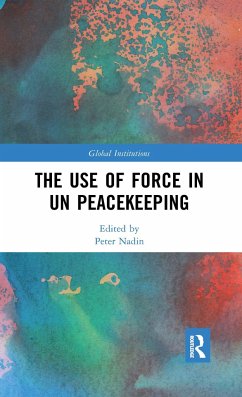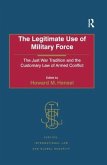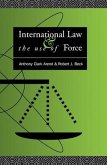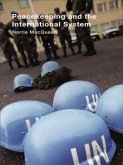The Use of Force in UN Peacekeeping
Herausgeber: Nadin, Peter
The Use of Force in UN Peacekeeping
Herausgeber: Nadin, Peter
- Gebundenes Buch
- Merkliste
- Auf die Merkliste
- Bewerten Bewerten
- Teilen
- Produkt teilen
- Produkterinnerung
- Produkterinnerung
This edited volume provides a detailed and nuanced analysis of UN peacekeeping and the use of force, to inform a better understanding of the complex and interconnected issues at stake for the UN community.
Andere Kunden interessierten sich auch für
![Public Opinion and the International Use of Force Public Opinion and the International Use of Force]() Philip Everts (ed.)Public Opinion and the International Use of Force168,99 €
Philip Everts (ed.)Public Opinion and the International Use of Force168,99 €![The Legitimate Use of Military Force The Legitimate Use of Military Force]() The Legitimate Use of Military Force168,99 €
The Legitimate Use of Military Force168,99 €![Ethics and the Use of Force Ethics and the Use of Force]() James Turner JohnsonEthics and the Use of Force186,99 €
James Turner JohnsonEthics and the Use of Force186,99 €![The European Union and the Use of Military Force The European Union and the Use of Military Force]() Tommi KoivulaThe European Union and the Use of Military Force185,99 €
Tommi KoivulaThe European Union and the Use of Military Force185,99 €![International Law and the Use of Force International Law and the Use of Force]() Anthony Clark ArendInternational Law and the Use of Force169,99 €
Anthony Clark ArendInternational Law and the Use of Force169,99 €![Peacekeeping and the International System Peacekeeping and the International System]() Norrie MacqueenPeacekeeping and the International System227,99 €
Norrie MacqueenPeacekeeping and the International System227,99 €![Strategic Culture, Securitisation and the Use of Force Strategic Culture, Securitisation and the Use of Force]() Wilhelm MirowStrategic Culture, Securitisation and the Use of Force196,99 €
Wilhelm MirowStrategic Culture, Securitisation and the Use of Force196,99 €-
-
-
This edited volume provides a detailed and nuanced analysis of UN peacekeeping and the use of force, to inform a better understanding of the complex and interconnected issues at stake for the UN community.
Produktdetails
- Produktdetails
- Verlag: Routledge
- Seitenzahl: 342
- Erscheinungstermin: 14. Februar 2018
- Englisch
- Abmessung: 222mm x 145mm x 22mm
- Gewicht: 562g
- ISBN-13: 9781138686861
- ISBN-10: 1138686867
- Artikelnr.: 52715309
- Herstellerkennzeichnung
- Libri GmbH
- Europaallee 1
- 36244 Bad Hersfeld
- gpsr@libri.de
- Verlag: Routledge
- Seitenzahl: 342
- Erscheinungstermin: 14. Februar 2018
- Englisch
- Abmessung: 222mm x 145mm x 22mm
- Gewicht: 562g
- ISBN-13: 9781138686861
- ISBN-10: 1138686867
- Artikelnr.: 52715309
- Herstellerkennzeichnung
- Libri GmbH
- Europaallee 1
- 36244 Bad Hersfeld
- gpsr@libri.de
Peter Nadin is an independent researcher based in Sydney, Australia. He has worked previously as a research assistant at the United Nations University, and interned with the UNU Institute for Sustainability and Peace and the UN Department of Peacekeeping Operations. His research interests include the politics of the UN Security Council and UN Peacekeeping Operations.
Introduction
Part 1: Questions of Doctrine
1. The case of East Timor: Ancient history or the shape of things to come? 2. Action adapted to circumstance: Peacekeeping doctrine and the use of force
3. Between absolute war and absolute peacekeeping
4. Implications of stabilisation mandates for the use of force in UN peace operations
5. Understanding the utility of the UN military component to protect civilians in different scenarios
6. Protecting civilians with force: Lessons and dilemmas from the UN Stabilisation Mission in Haiti
7. The 'All necessary means'
to what ends? The unintended consequences of the use of force by UN Peacekeepers
8. The logic of force in UN peacekeeping: A policy primer
Part 2: Questions of Practice
9. Leadership in UN Missions
10. The use of force and the civil-military dimension
11. Generating the ability: The challenges of force generation
12. UN peacekeeping and international law
Conclusion.
Part 1: Questions of Doctrine
1. The case of East Timor: Ancient history or the shape of things to come? 2. Action adapted to circumstance: Peacekeeping doctrine and the use of force
3. Between absolute war and absolute peacekeeping
4. Implications of stabilisation mandates for the use of force in UN peace operations
5. Understanding the utility of the UN military component to protect civilians in different scenarios
6. Protecting civilians with force: Lessons and dilemmas from the UN Stabilisation Mission in Haiti
7. The 'All necessary means'
to what ends? The unintended consequences of the use of force by UN Peacekeepers
8. The logic of force in UN peacekeeping: A policy primer
Part 2: Questions of Practice
9. Leadership in UN Missions
10. The use of force and the civil-military dimension
11. Generating the ability: The challenges of force generation
12. UN peacekeeping and international law
Conclusion.
Introduction
Part 1: Questions of Doctrine
1. The case of East Timor: Ancient history or the shape of things to come? 2. Action adapted to circumstance: Peacekeeping doctrine and the use of force
3. Between absolute war and absolute peacekeeping
4. Implications of stabilisation mandates for the use of force in UN peace operations
5. Understanding the utility of the UN military component to protect civilians in different scenarios
6. Protecting civilians with force: Lessons and dilemmas from the UN Stabilisation Mission in Haiti
7. The 'All necessary means'
to what ends? The unintended consequences of the use of force by UN Peacekeepers
8. The logic of force in UN peacekeeping: A policy primer
Part 2: Questions of Practice
9. Leadership in UN Missions
10. The use of force and the civil-military dimension
11. Generating the ability: The challenges of force generation
12. UN peacekeeping and international law
Conclusion.
Part 1: Questions of Doctrine
1. The case of East Timor: Ancient history or the shape of things to come? 2. Action adapted to circumstance: Peacekeeping doctrine and the use of force
3. Between absolute war and absolute peacekeeping
4. Implications of stabilisation mandates for the use of force in UN peace operations
5. Understanding the utility of the UN military component to protect civilians in different scenarios
6. Protecting civilians with force: Lessons and dilemmas from the UN Stabilisation Mission in Haiti
7. The 'All necessary means'
to what ends? The unintended consequences of the use of force by UN Peacekeepers
8. The logic of force in UN peacekeeping: A policy primer
Part 2: Questions of Practice
9. Leadership in UN Missions
10. The use of force and the civil-military dimension
11. Generating the ability: The challenges of force generation
12. UN peacekeeping and international law
Conclusion.








